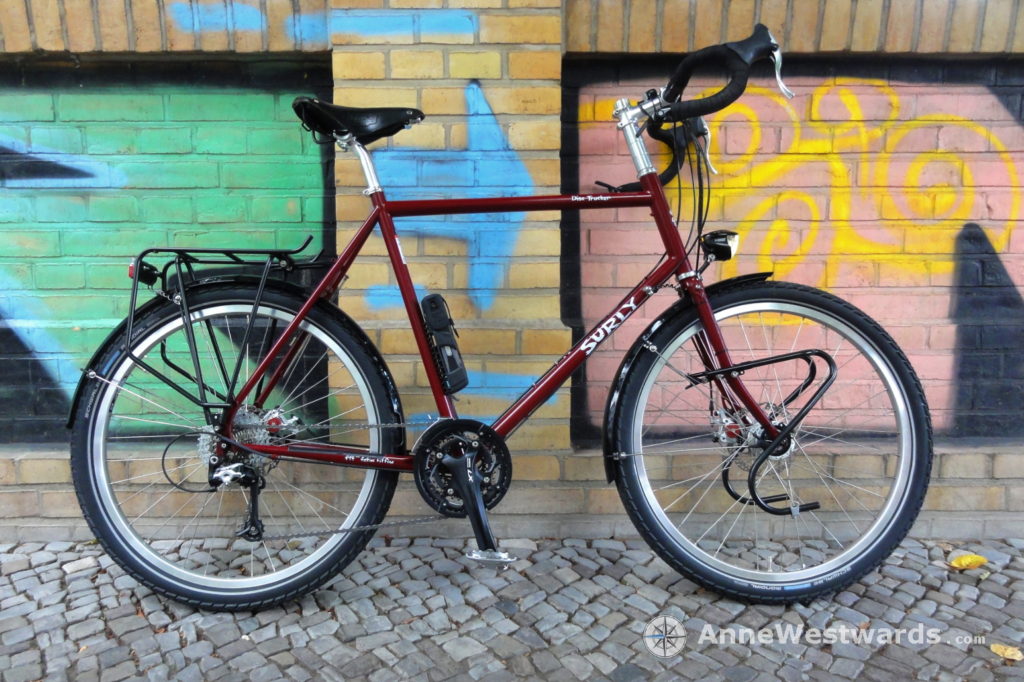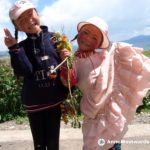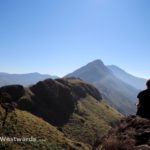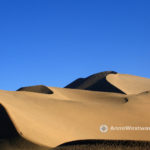
Gear list as of May 2016:
My aims are to carry as little as possible, but at the same time be self-sustainable. I know, these two goals somewhat contradict each other. However, I want to be able to cycle in areas with little to no human habitation. That means bringing complete camping gear, as well as water purifier, e.g., but also a long list of spares and tools to repair pretty much anything on my bike and gear. The following list is not exhaustive (yet), but I am getting there: clothing, camping gear, electronics and my bike setup.
A. Clothing
In essence, I carry one set of clothing for cycling (many layers, to adjust for a wide range of temperatures) as well as one set of clothing for sleeping / time at camp. The latter is also functional clothing, such that I can also use it as a spare for cycling if all of my cycling gear is drenched and does not get dry. I have been grateful to have packed clothing for a wide range of climates, as I have encountered anything from freezing nights in the mountains where the temperature dropped below -20°C to deserts where the thermometer topped +45°C. If you use this list as an inspiration, adjust accordingly to the climates you will likely encounter.
Sleeping / camp time:
- 1 pair of long thin hiking pants
- 1 pair of thermal pants (cold temperatures)
- 1 functional T-shirt
- 1 fleece sweater
- 1 down jacket
Cycling:
- 1 pair of cycling shorts (plus knee warmers to extend them to mid-calf-length in conservative regions)
- 1 pair of wide shorts to wear on top (most traditional/conservative regions don’t appreciate tight shorts)
- 1 pair of thermal pants (long)
- 2 T-shirts (to be able to dry one while wearing the other)
- 1 long sleeve shirt (thermal)
- 1 wide cotton blouse (against intense sun and in high temperatures)
- 1 thin fleece sweater
- 1 outdoor jacket (e-vent, breathable)
Rain gear:
- 1 rain jacket
- 1 pair of rain pants (also good for extra warmth on long descents)
- 1 pair of waterproof overshoes (same as rain pants: also good for providing warmth)
- over-gloves for rain
- rain cape (also used for sheltering my bike from longer rains)
Feet:
- 1 pair of light, clipless cycling shoes (warm weather)
- 1 pair of light, waterproof hiking boots (cold weather)
- 1 pair of flipflops (bathrooms, camp)
Miscellaneous:
- 1 pair of sunglasses (Alpina tri-effect, changeable lenses for different conditions)
- underwear: 4 panties, 2 sports bras
- 4 pairs of socks: 1 light (cotton), 1 medium warm, 2 warm (woolen) pairs
- neck and head :
- heat: brimmed sun hat, 2 cotton buffs (also good to cover my face and head up completely in sand storms)
- cold: 1 buff and 1 hat from fleece,
- extra cold: 1 extra-warm wool + double fleece hat (for nights and long mountain descents),
- hands:
- heat: 1 pair of fingerless cycling gloves
- chill: 1 pair of long cycling gloves
- cold: 1 pair of skiing gloves (saved my life in the winter), woolen wrist warmers (to add warmth in all of these cases)
B. Camping
Sleeping
- tent: Vaude Odyssey (2-person, 3-seasons) – gives a little extra space to bring my panniers in and is long enough to host a giant like me (6 feet / 1.83m)
- footprint: cheap tarp from a hardware store
- tent pegs: super-lightweight pegs that came with the tent, 4 extra tent pegs that are longer and more suited for sand
- sleeping bag: Ajungilak Kompakt 3-seasons (synthetic fiber)
- silk inlet (Sea to Summit)
- sleeping pad: Therm-a-Rest ProLite Plus (3-seasons)
- headlamp: Petzl Tikka
Cooking/Food
- stove: MSR Whisperlite International + MSR fuel bottle (1l)
- cooking ware: aluminium pot with lid, 1 set of cutlery (army shop), 0.5l mug that doubles as a tiny pot
- water:
- purification system: Care plus (from Sawyer) + 2l dromedary bag from Ortlieb
- tablets: Katadyn Mircopur forte
- water transportation:
- mainly 4 bottle holders in bike frame, capacity: 3x big bottles (1.5 litres), 1x regular bottle (1litre)
- 10l dromedary bag from MSR
- 2l dromedary bag from Ortlieb (also used for water purification, see above)
Hygiene
- toothbrush and toothpaste (concentrate)
- deodorant
- if there is water to clean myself/dishes/whatever else
- allround outdoor travel soap concentrate (by Ortec)
- 5l folding bowl from Ortlieb
- tiny towel bought a decade ago in China
- if there is no water
- baby wipes
- hand sanitizer
C. Electronics, Navigation, Safety
Again, this is a list that reflects what is important for me personally on my tour – being able to express myself as a writer and photographer, as well as to have enough redundancy and emergency devices for very remote areas. For many tours, this will not be necessary. As people ask me frequently about my choice of a tablet instead of a laptop: much lighter and smaller than a laptop, with stunning battery service life of nearly 16h and, most importantly, chargeable with my bike dynamo (via a battery pack and USB).
- Fotography/videos (each with 3 chargeable batteries and charger);
- DSLR camera: Canon EOS 700D with 18-135 IS STM lense and UV filter (new at the start of the tour)
- compact camera: Sony Cyber-shot DSC-HX5 (backup, dating from 2010)
- action cam: QUMOX SJ4000
- tablet: Lenovo Yoga 2 + external keyboard (for easier typing)
- power: two battery packs (for charging while cycling, less abuse of the batteries of my devices)
- storage: external harddrive, card reader, multiple SD cards
- navigation:
- for GPS: 2 smart phones (each with two extra batteries)
- oldstyle: paper maps of the country I am cycling in (and the upcoming)
- safety:
- Personal Locator Beacon (PLB) for sending an emergency signal in case of a life-threatening incident (model: ACR Electronics ResQLink+)
- pepper spray against dogs
- whistle
- visibility vest (a present from an Australian cyclist-friend on the road in Uzbekistan)
- additional battery-powered rear light (mine is quite often hidden from view underneath things dangling from the rear of my bag)
D. Bike setup
My bike Emily is the result of a long thought and research process: custom-built according to my specifications by a small group of bike enthusiasts in Berlin. No tour is the same and no person, so Emily’s setup will not fit everyone and every tour. I wanted her to be very durable, a sturdy bike for roads as well as rough terrain, suitable for heavy loads and for the mountains, with parts that I can repair myself and for most of which I can find replacements also outside of Europe / North America (if not, I carry spares). If you have any questions concerning the choices, please do not hestitate to contact me. I’ll be happy to explain my reaosons behind the components.
In brief: Disc Trucker frame by Surly, disc brakes, 26” wheels, dropped handlebars, 10-speed drive train, mostly Shimano components, carrying system for 6.5l water/fuel on the frame.
Specifications in more detail:
- frame: Surly Disc Trucker (steel)
- what to roll on
- wheels: 26”, hand-built, 36 spokes
- hubs: SHIMANO Deore XT (rear: FH-M8010 Disc, front: HB-M8010 Disc)
- rims: Ryde Sputnik
- tires: Schwalbe Maraton Mondial (26×2”)
- how to get rolling: drive train
- cassette: Shimano SLX/LX CS-HG81-10 (11-13-15-17-19-21-24-28-32-36)
- crank set: SHIMANO Deore LX FC-T671 Hollowtech II (44-32-24)
- front and rear derailleur: Shimano Deore XT
- shifters: bar end shifters from Microshift
- chain: Shimano XT CN-HG95 HG-X / SRAM PC1091 (one as a spare)
- pedals: Shimano PD-A530 (combination pedals)
- how to stop: brakes
- disc brakes: Avid’s BB7
- discs: Shimano SM-RT54-S, diameter 160
- levers: Tektro Aero Lever
- saddle: Brooks B17
- dropped handlebar: Salsa cowbell
- dynamo powered headlight with USB charger: LUMOTEC IQ2 LUXOS (b+m)
- carrying system:
- rear rack: Tubus cargo, 2 Ortlieb panniers, 1 40l Quechua duffel bag on top
- front rack: Tubus duo, 2 Ortlieb lowriders
- 1 Ortlieb handlebar bag (ultimate 4)
- bottle cages: 3 inside the triangle of the frame, 1 below (total of 6.5l capacity)
- miscellaneous
- bike computer: Sigma BC 14.12 ALTI
- bell: Mounty Special Charly
- lock: long cable and (relatively) cheap padlock from hardware store
E. Tools and spares
As I mentioned, this list is long to enable me to be self-sustainable also in countries with very remote stretches – countries that may have one bike shop in the capital, but nowhere else. Not every tour will need such a wide range of spares and tools, of course. As spares, I usually carry the same models that I already have on my bike.
Spares
- 1 spare tire (folding version of the tires I ride, Schwalbe Marathon Mondial, 26×2”)
- 2 spare tubes (26”, Schwalbe)
- 1 spare chain (same as the one I ride), 3 SRAM powerlock links
- 1 spare cassette (same as the one I ride; added this for my Mongolia ride)
- 2 spare brake pads (last very long), 1 extra disc rotor
- spare cables for breaking and shifting
- spare electric cables for my dynamo and light system
- several spare spokes (front and back)
Tools
- general purpose
- zip ties in 3 different strengths
- pocket knife
- multi-purpose pliers
- tiny saw
- strong needles and threads
- safety pins
- repair kit for MSR stove
- patches and glue for tent repairs
- tape
- Duct/Gaffa/power tape (you know which one- the one that can fix ANYthing into place)
- aluminium tape (great for fixing water bottles; got that from an Italian aerospace engineer)
- iso tape (for electric wires and deep scratches in the frame)
- bike specific
- multi tool (Topeak Alien II)
- tire levers (Xtreme pro composite)
- pump Zefal HPX
- puncture patches and glue (for tubes)
- tire patches (same for tires, Park Tool TB-2)
- chain lubricant
- chain wrench
- spoke wrench (Park Tool)
- cassette lockring remover (Shimano TL-LR15 HG/IG)
August 2015:
My gear is work in progress. The choices are tough – these are going to be my travel companions for months on end. While there items that always have found a spot in my luggage and will again (my travels have been accompanied by the same, reliable functional sweater since 2002), there are others that are still up for debate.
The single most important piece of gear I already have; Emily, my trusted companion for this trip. A tough touring bike, custom-built around the Disc Trucker frame by Surly. Emily is the result of a thought and learning process – after all, I originally set out with very little knowledge about the requirements for touring bikes. Thus, I spent many weeks researching, reading, discussing about every single component – and the result is Emily. Even though I have only cycled on her for a bit more than a month now, I am already in love with her! And yes, my bike is female. I decided that this is a trip among women.




I’m not that much of a internet reader to be honest but your
blogs really nice, keep it up! I’ll go ahead and bookmark your site to come back down the road.
Cheers
Very interesting blog and so well written, thank you!
I’m searching for passionate bike technicians to build my touring bike – would you please be so kind and let me know who helped you to build yours?
And: how did you learn to repair it? Attending workshops?
Thanks a lot and good luck for all your future adventures.
Susanne